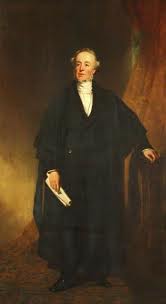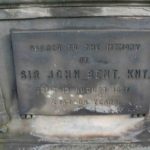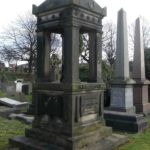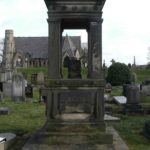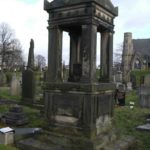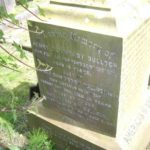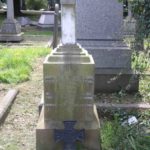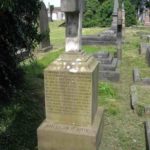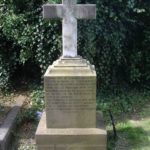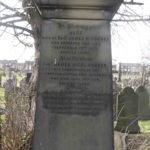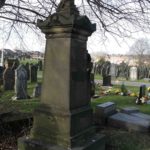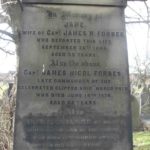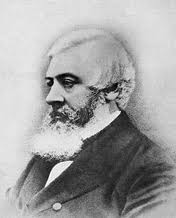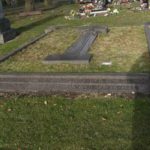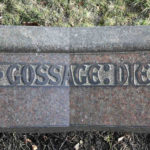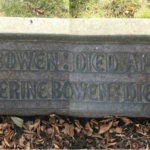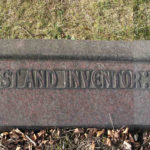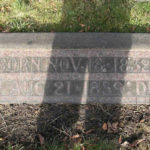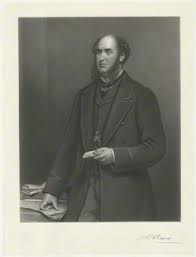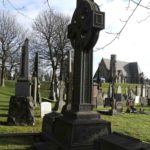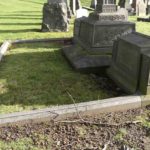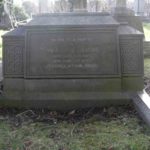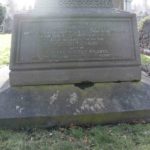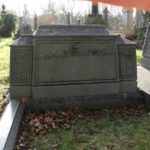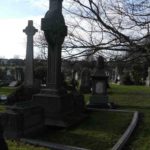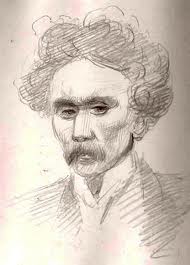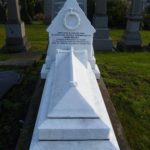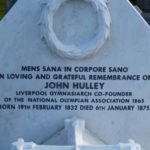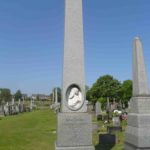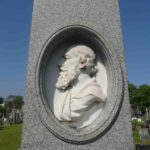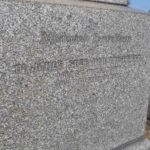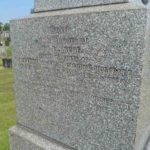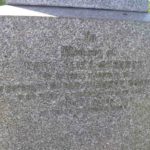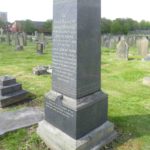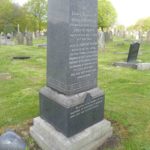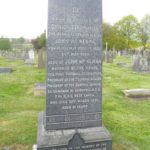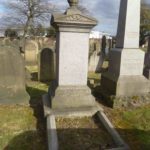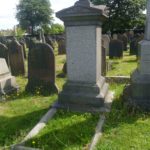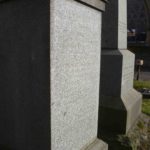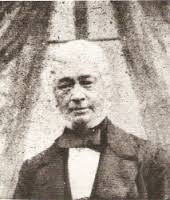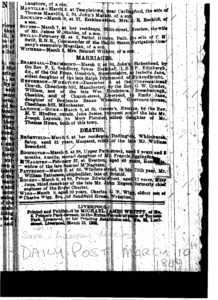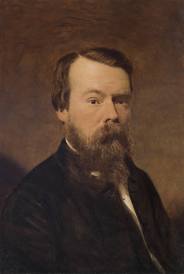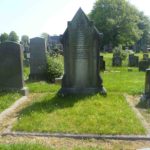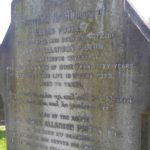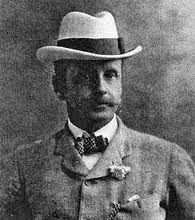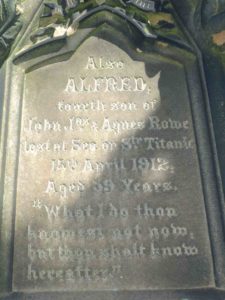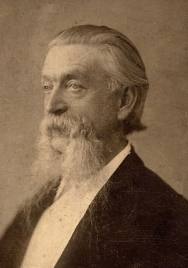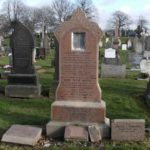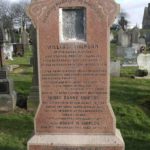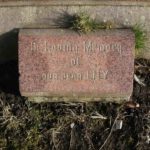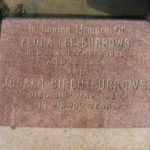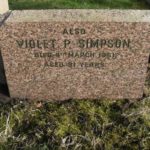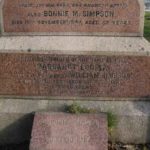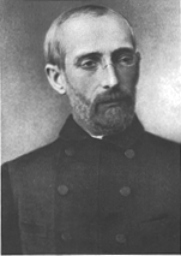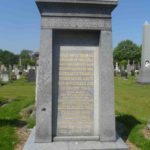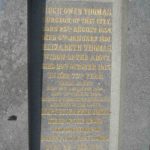NOTABLE INTERRED IN TOXTETH PARK CEMETERY
Within 57 years of the pening of Toxteth Park Cemetery over 144,000 people had been interred, ranging from ordinary Liverpool folk, to James Dunwoody Bulloch (see below) to a Mr Alfred Rowe (see also below) who died on Titanic. Also laid to rest there is Mary Billinge, reputedly the oldest woman in Liverpool, she was interred on 26th December 1863 at the grand old age of 112 years and 6 months. Below is a list of notable people buried in the cemetery, with a brief history of their lives.
BENT, JOHN, Sir Knt - born in 1793
he was the owner of Bent’s brewery and Lord Mayor of Liverpool from 1850 to 1851. In October 1851, John was knighted at the Town Hall when Queen by Victoria came to Liverpool. It was stated in the local press”with much pomp and splendour and the streets thronged with people”. He died on 13th August 1857 at his home in Rake Lane (now West Derby Road), Edge Hill.
Sir John is interred in Section K, Grave 1012 & 1013, Consecrated Section.
BOGUE, ROBERT LACHLAN, born on 5th November 1820,
Robert was a master at Liverpool College for 44 years and head from 1873 & 1890 to 1891. He lived at 17 Oxford Street, and was held in quite high regard by his pupils, one saying of John “He helped boys to an all round gentlemany character and bearing”. On his retirement he was presented with an “illuminated address and a purse of pure gold”. He died on 14th September 1903 aged 83 years, leaving in his will £125 to the Liverpool Hospital for Consumption.
Robert Lachlan is interred in Section K, Grave 980, Consecrated Section.
BULLOCH, JAMES DUNWOODY,
Born on the 25th June 1823 near Savannah, Georgia, the only child of Major James Stephens Bulloch and Esther Amarintha Elliot and was Theodore Roosevelt uncle. He married Elizabeth Caskie in 1851 and after Elizabeth’s death he married Hariott Cross Foster, and had five children. Bulloch was sent to England by the Confederate States Government as one of their chief secret agents and he arrived in Liverpool on 4th June 1861. His mission was to obtain warships and armaments for the Confederacy Navy (including purchase of the Sea King which was renamed the CSS Shenandoah), to help lift the blockade by the Northern states of the Southern ports. As secret Confederate agents, James and his half brother Irvine were never pardoned in the general amnesty that came at the end of the Civil War. James therefore decided to became a British citizen and remained in Liverpool, where he became cotton importer and broker and became quite successful. James Bulloch died from cancer and cardiac failure on the 7th of January 1901 at 76 Canning Street, Liverpool aged 77.
James Dunwoody is interred in Section H, Grave 960, Consecrated Section.
On his grave is inscribed
“An American by birth, an Englishman by choice.”
COMMELIN, JOHN
an inspector of the Liverpool Fire Brigade. On 28th July 1861 he was killed by the” falling of a wall” after a large fire at the premises of Messers Garnock Bibby & Co on Wavertree Road, Liverpool. He died at the age of 39 and left a wife and a young family.
John is interred in Section S, Grave 130, Consecrated Section.
CROSS, WILLIAM
born in Camberwell, London in 1840 and followed in his fathers footsteps into the business of animal dealing. He became one of the biggest dealers in wild animals in the world and eventually had his main menagerie in Earle Street. He was even compared to Phineas T. Barnum, but William was more a collector of exotic animals than a showman. He supplied the first living gorilla ever seen in England, he was an engaging companion, twice married he died on 7th April 1900.
William is interred in Section P, Grave 382, Consecrated Section.
CUNARD, JOSEPH
CUNARD, JOSEPH was born at Halifax, Nova Scotia, Canada in 1799, the son of Abraham Cunard and Margaret Murphy. After attending Halifax Grammar School Joseph entered his father’s firm and by 1820 he and his brother Henry moved to Chatham, New Brunswick, Canada. On Miramichi River they were to become involved lumbering, milling, and shipping on the south side of the river. A massive man standing over six feet tall and weighing over 200 pounds, he was described as the wealthiest merchants in the province.
In 1833 Joseph married Mary Peters, the daughter of Judge Thomas Peters of Bushville, and produced two sons.
In 1850 Joseph he left the area, and settled with his brother Samuel (founder of The Cunard Shipping Line) in Liverpool. He entered business selling ships, lumber and goods on commission for merchants in the colonies.
He died on 16th January and was interred on 20th January 1865.
Joseph is interred in Section Q, Grave 3o, Consecrated Section.
FORBES, JAMES NICOL (BULLY)
FORBES, JAMES NICOL (BULLY), born in Aberdeen in 1822 he was to become one of the most famous sea captains of his day, and the pride of the Black Ball line.
With his red hair and a scar above his right eye, he had a reputation for fast passages which brought him to the attention of James Baines owner of The Black Ball line.
After captaining couple of vessels for Baines, Forbes was hired to take command of the new clipper ship, it was to become synonymous with Forbes, the “Marco Polo”. He was even to have a small share in the venture himself. “Marco Polo” was a large and fine vessel 185 feet long, built by Marsh Creek, Courtney Bay, New Brunswick in 1851.
The first voyage Forbes made to Australia in the “Marco Polo” was in 1852, At the farwell dinner given before the vessel sailed, Forbes remarked “Do not be surprised if you see me back in the Mersey again within six months”. The audience scoffed, but he achieved the round trip to Melbourne and back to Liverpool in 3 months and 21 days, so Forbes had made good his boast.
On arrival at Victoria in Australia in 1852, Forbes found the entire colony in ferment, gold had been discovered. Whole crews had deserted their ships, Forbes promptly had his crew imprisoned on a charge of insubortination. They were kept in prison until he was ready to set sail. They left for Liverpool on October 11th 1852 and she anchored in the Mersey on December 26th, 76 days later.
When he set out on his next trip, Forbes was even more boastful. As soon as sail was set he said to the passengers assembled on the deck, “On my last trip I astonished the world. This trip I intend to astonish The Almighty.
His career was ended for the Black Ball line, when Forbes ran aground the ship “Schomberg” at Cape Orway in Australia on 26th December 1855, it was her maiden voyage. It was reported Forbes was playing cards at the time, although the subsequent hearing absolved him of any blame.
Afterward he was given more modest vessels such as “Hastings” and “General Wyndham” which plied trade between Liverpool and India.
It is little wonder that Forbes earned the name “Bully Forbes” with his curt manner, even to passengers and crew on board his vessels. On one voyage during a fierce storm enroute to Australia, even the passengers themselves became so frightened at the way in which he was sailing the vessel that a deputaion wanted him to “shorten the sails”. Forbes reply was a curt refusal, barking “This is a case of Hell or Melbourne”. Forbes is even immortalised in the folk song “Marco Polo” about his captaining the ship.
After 1869 he appears to have settled down, living in Westbourne Street, until his death on 14th June 1874.
James is interred in Section M, Grave 27, Un-Consecrated Section.
CLICK HERE TO VIEW THE LYRICS TO FOLK SONG ABOUT JAMES NICOL FORBES (BULLY)
GOSSAGE, WILLIAM
born in the village of Burgh-Le-Marsh Lincolnshire in 1799. William was a chemist and engineer, and after opening a chemical plant in Widnes producing alkalis, he produced soap at a much lower cost than at the time. He died at his home in Dunham Massey on April 9th 1877. His estate was estimated to be under £160.000.
William is interred in Section B, Grave 332/334, Un-Consecrated Section.
GRAVES, SAMUEL ROBERT
born on 7th June 1818 born in Ireland. He married Elizabeth Haughton, daughter of Samuel Haughton of Burrin House, Carlow in 1848. Samuel was a Conservative politician and merchant ship owner, and a director of the London and North Western Railway. He was also on the Commission to inquire into the management of Lights, Buoys, and Beacons.
Samuel was Lord mayor of Liverpool in 1861, and in the 1865 general election was elected Member of Parliament for Liverpool. He held the seat until his death on 18th January 1873. A statue was erected in his honour in St George’s Hall.
Samuel is interred in Section I, Grave 324 & 325, Consecrated Section.
HULLEY, JOHN
was born on 19 February 1832 at 10 Gloucester Street, Liverpool. Born and bred in the city he is the forgotten man of British Olympic History. At his Liverpool Gymnasium in 1865 he established the National Olympian Association, and by organising Olympic Festivals at his Gymnasium in 1862, 1863, 1864 and 1865 he was the instigator of the Olympic movement in England.
In January of 1869 he introduced the Velocipede to England from Paris, seeing the benefit of it for exercise and profit.
John married Georgiana Bolton on 16 July 1869 at the Ancient Unitarian Chapel, Toxteth Park. Georgiana was the only daughter of Mr. Robert Lewin Bolton, merchant of Liverpool. They had one child Georgiana Theodosis who was born in December of 1870,
He died in 1875 aged 43 at his home at 91 Grove Street, he was survived by his wife and daughter. His grave was “re discovered” in 2008 and a movement is now under way to try and get him the recognition he rightly deserves, for his part in Olympic History.
John is interred in Section G, Grave 493, Un-Consecrated Section.
MUSPRATT, JAMES SHERIDAN
eldest son of James, was born in Dublin on 6 March 1821. He was to achieve fame as a research chemist and teacher. His most influential publication was his two-volume book “Chemistry, Theoretical, Practical and Analytical as applied and relating to the Arts and Manufactures” (1857–1860). In 1848 James founded the Liverpool College of Chemistry in a disused stable at the back of his house in Canning Street. He also took a keen interest in theatre and helped to organise a visit to Liverpool of Charles Dickens’s amateur company in 1847. Among the cast were the American actress Susan Webb Cushman. James married Susan in 1848 and they had three daughters but unfortunately Susan died in 1859. James then married an Ann Neal of Rainhill the following year, they had no children. James died at his home in West Derby, on February 3 1871.
James is interred in Section C, Grave 493, Un-Consecrated Section.
McKENNA, JOHN (Honest John)
born on 3rd January 1855 in County Mounaghan in Ireland. He was a self made business man and rugby player, but will be best remembered for being the first manager of Liverpool Football Club. He moved to Liverpool in the 1870’s to search for employment finding work as a grocer’s boy and then taking the role as a vaccination officer for West Derby Union. He was to become involved in the West Lancashire Rugby Union but it was through his politics and religious beliefs that John would meet John Houlding. It was through Houlding, that John’s passion for Association Football would surface when he was invited to Anfield to watch (strangley enough) the Everton team play. When Everton moved to Goodison Park in 1892, Houlding and McKenna remained at Anfield, and John was to become the driving force behind Liverpool Footbal Club’s formative years, managing the team from 1892 to 1896. He would acquire players where he could, but mostly from Scotland, and his team were known as “Team of Macs”
They were admitted into Footbal League and played their first game, beating “Middlesbrough Ironopolis” 2-0 on 2nd September 1893.
He held the position of club chairman from 1906 to 1915, becoming President of the Football League in 1917 a position which he held the until his death.
“Honest” John McKenna Died on 22nd March 1936 and is buried with his wife Charlotte.
John is interred in Section E Left, Grave 149, Consecrated Section.
OGDEN, THOMAS
born in Liverpool 1832. In 1860 founded The Ogdens Tobacco Company. He died in August 1890 at the age of 58.
The Inscription reads, Sacred to the memory of Mary, the beloved wife of Thomas OGDEN, who died August 21st 1860, aged 22 years. Also Thomas, son of the above, who died August 11th 1860, aged 15 weeks. Thomas OGDEN, born 18th Oct. 1832, died 23rd Augst 1890.*The memory of the just is blessed.* Jane Edith OGDEN, born 14th September 1843, died 23rd July 1926. *In Thee O Lord have I trusted.*
Thomas is interred in Section C Left, Grave 410, Consecrated Section.
PATTERSON, WILLIAM
Born in poverty in Arbroath, Scotland in 1795. William grew up with shipbuilding in London as a ward of a London slop-seller, and was to become an innovator in ship construction. At the age of 15 William was apprenticed to a shipbuilder in Rotherhithe, then foreman to William Evans a well known ship builder. In 1822 he took charge of Evans yard and on his own account completed a steam packet for the Post Office, the Dasher.
He moved to Bristol in 1823 and became assistant to ship owner William Scott, when Scott embarked on shipbuilding at East Wapping. The following year he married Eliza Manning at St Mary Redcliffe Church raising an amazing 11 children.
In 1830 Scott became bankrupt and by 1831 William had taken ownership of the Wapping Yard. He was to collaborate with Isambard Kingdom Brunel on the design and construction of the SS Great Britain and SS Great Western. William actually drew the plans for SS Gt Britain.
Patterson’s wife died in 1865 and he retired to Liverpool. William died on 8th March 1869 at 65 Windsor Street, Liverpool. He was interred on 12th March 1869 in Section F, Grave 83, Consecrated Section.
Amazingly, for such a prominent and gifted man, there is no memorial or headstone for William or his achievements.
My thanks go to Ann Bronnert for informing me about William as he is her husbands 4x great uncle.
(A much more concise biography of William and his link to Brunel and SS Great Britain can be found by clicking on the link below.)
PICTON, Sir JAMES ALLANSON
eminent historian and architect was born in Liverpool on 2nd December 1805. He participated in local religious and philanthropic work and designed some of Liverpool’s most important buildings. Sir James devoted himself to the promotion of public libraries, and when the Corporation extended the library in William Brown Street, they named a reading room after him. James was married twice, firstly to Margaret Beauont, daughter of John Beaumont of Manchester; and secondly Jessie Carr Williams, daughter of Sydney Williams a publisher and had four sons. He died on 15th July 1889 in Wavertree.
James is interred in Section H, Grave 380/1, Un-Consecrated Section.
ROWE, ALFRED
was born in Lima, Peru on 24 February 1853, the son of John James and Agnes Rowe of Liverpool. He was one of seven children. Alfred later moved to England, and then, in 1879, settled in Donley County, Texas, where he started a ranch with his brothers Vincent and Bernard. In 1910, Alfred had moved back to England with his wife and children. He returned a few times a year to check on his ranch, which he had left with a manager. For his last trip Alfred booked passage on the Titanic as a first class passenger his ticket costing £26 11s, about £1,679.00 in todays money. After the sinking of Titanic some accounts suggested that he swam to a piece of ice where he was later found frozen to death. His body was recovered by the Cable Ship “Mackay-Bennett”.
Alfred is interred in Section I, Grave 346/7, Consecrated Section.
SIMPSON, WILLIAM SHAW
born in Lancaster on 18th June 1829. His father was manager of the old Zoological Gardens, West Derby Road, but he died when William was young, William was a man bordering on eccentricity and in April 1877 he took ownership of a refreshment store at Liverpool landing stage. He raised funds for the poor and needy and during the India famine of 1877 he placed a copper bowl on his landing stage premises, it raised £203. In 1873 he had been an unsuccessful candidate as an Independent at the Parliamentary Elections, standing for the cause of the working man.
The year before his death, William was thrown out of his trap while travelling with his daughter, this may have hastened his death as he never seemed to recover from it. He died suddenly on 18th June 1883.
He was an advocate of temperance, and two years after his death a public drinking fountain to commemorate his name was opened at Liverpool’s Parish Church of St Nicholas’s by James Picton.
William is interred in Section P, Grave 380, Consecrated Section.
THOMAS, HUGH OWEN
may well be called “The father of modern orthopaedic surgery”. Born in Bodedern, Anglesey in 1834 he studied medicine at Edinburgh. Hugh moved to Liverpool at the age of 19, spending much of his time in the slums of Liverpool, treating the poor rather than the affluent middle classes, he invented several types of splints with rigid steel bars. Hugh was known as an eccentric and rather temperamental man and rumour had it that he would attack victims himself, and break their bones, in order to have patients on which to practice. He was short just over five feet tall, always wore a black coat buttoned all the way up, a patch over one eye, and constantly had a cigarette in his mouth. Among the poor people of Liverpool though, he was held in great esteem. He practiced from his home in No. 11, Nelson Street, where he worked all day from five or six in the morning, and every Sunday he would treat patients for free. He died on 6th January 1891 over worked at the age of 57.
At the outbreak of The Great War in 1914, his nephew Sir Robert Jones re-introduced his uncles ideas. Thanks to “The Thomas Splint” the mortality of compound fractures of the femur, fell from 80% to less than 8% by 1918. Hugh also created the “Thomas Collar” to treat tuberculosis of the cervical spine. His contribution to medicine was immense and not widely recognised until after his death.
Hugh is interred in Section D, Grave 1, Un-Consecrated Section.
